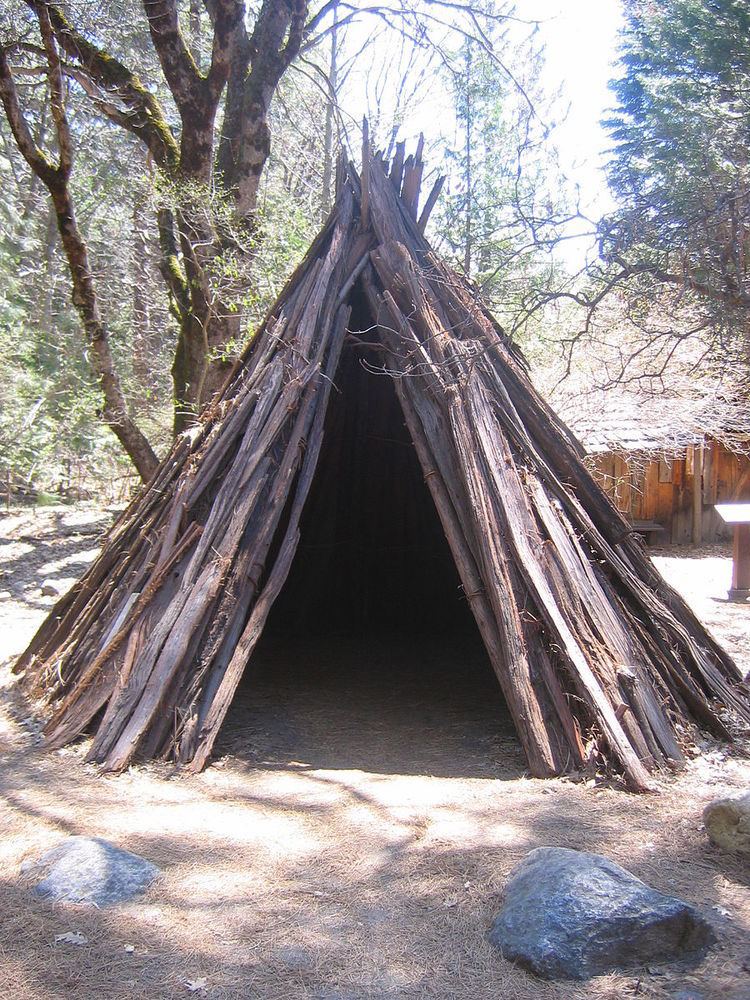 | ||
The Miwok (also spelled Miwuk, Mi-Wuk, or Me-Wuk) are members of four linguistically related Native American groups indigenous to what is now Northern California, who traditionally spoke one of the Miwok languages in the Utian family. The word Miwok means people in their native language.
Contents
Subgroups
Anthropologists commonly divide the Miwok into four geographically and culturally diverse ethnic subgroups. These distinctions were unknown among the Miwok before European contact.
Federally recognized tribes
The United States Bureau of Indian Affairs officially recognizes eleven tribes of Miwok descent in California. They are as follows:
Non-federally recognized tribes
History
The predominant theory regarding the settlement of the Americas date the original migrations from Asia to around 20,000 years ago across the Bering Strait land bridge, but one anthropologist claims that the Miwok and some other northern California tribes descend from Siberians who arrived in California by sea around 3,000 years ago.
Culture
The Miwok lived in small bands without centralized political authority before contact with European Americans in 1769. They had domesticated dogs and cultivated tobacco, but were otherwise hunter-gatherers.
Cuisine
The Sierra Miwok harvested acorns from the California Black Oak. In fact, the modern-day extent of the California Black Oak forests in some areas of Yosemite National Park is partially due to cultivation by Miwok tribes. They burned understory vegetation to reduce the fraction of Ponderosa Pine. Nearly every other kind of edible vegetable matter was used as a food source, including bulbs, seeds, and fungi. Animals were hunted with arrows, clubs or snares, depending on the species and the situation. Grasshoppers were a highly prized food source, as were mussels for those groups adjacent to the Stanislaus River.
The Miwok ate meals according to appetite rather than at regular times. They stored food for later consumption, primarily in flat-bottomed baskets.
Religion
Miwok mythology and narratives tend to be similar to those of other natives of Northern California. Miwok had totem animals, identified with one of two moieties, which were in turn associated respectively with land and water. These totem animals were not thought of as literal ancestors of humans, but rather as predecessors.
Sports
Miwok people played athletic games on a 110-yard playing field called poscoi a we’a. A unique game was played with young men and women. Similarly to soccer, the object was to put an elk hide ball through the goalpost. The girls were allowed to do anything, including kicking the ball and picking it up and running with it. The boys were only allowed to use their feet, but if a girl was holding it he could pick her up and carry her towards his goal.
Population
In 1770, there were an estimated 500 Lake Miwok, 1,500 Coast Miwok, and 9,000 Plains and Sierra Miwok, totaling about 11,000 people, according to historian Alfred L. Kroeber, although this may be a serious undercount; for example, he did not identify the Bay Miwok. The 1910 Census reported only 671 Miwok total, and the 1930 Census, 491. See history of each Miwok group for more information. Today there are about 3,500 Miwok in total.
Influences on popular culture
The Star Wars films feature a fictional species of forest-dwelling creatures known as Ewoks, who are ostensibly named after the Miwok. However, the historical Northern-California footprint of the Miwok people (where George Lucas's home and corporate headquarters were located) may have caused the Ewoks' name to be retconned to enhance the marketability of the 1983 film.
The Miwok people are encountered in Kim Stanley Robinson's book, The Years of Rice and Salt. In an alternate history scenario depicted in the book they are the first group of Native Americans encountered by the first Chinese to discover the continent.
